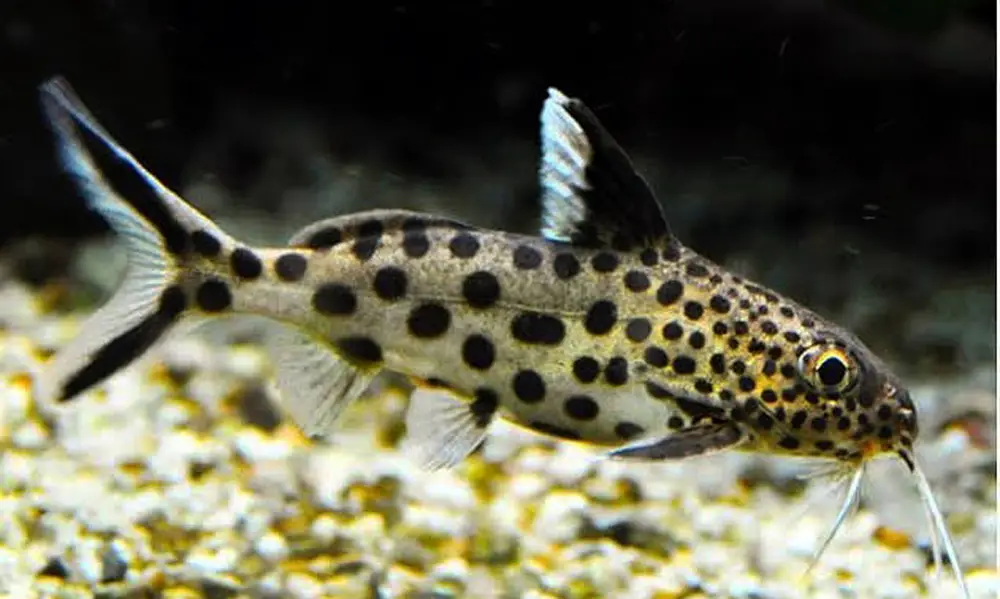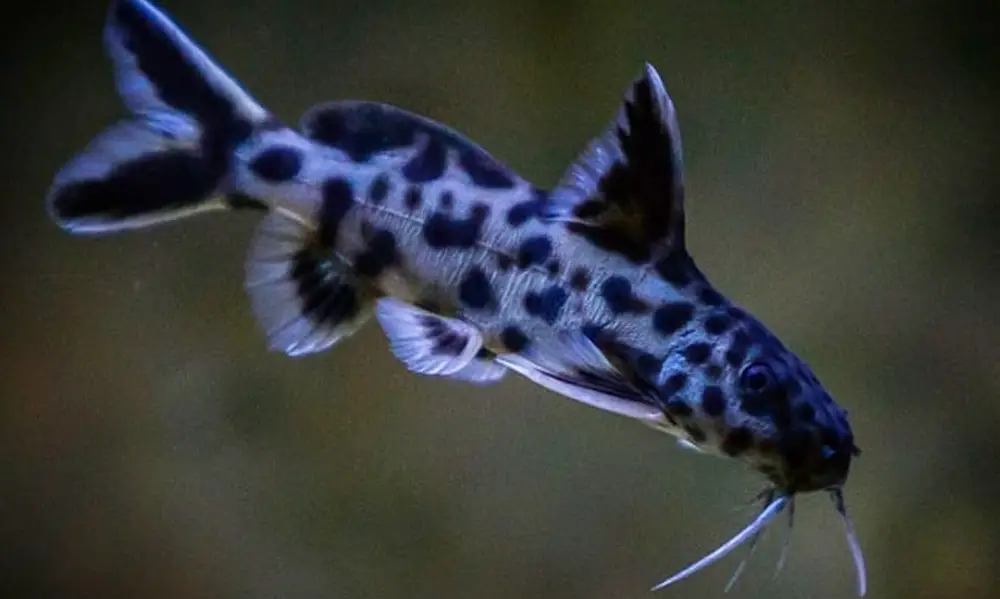Lake Tanganyika is home to a wide variety of fish, but it is perhaps best known for its cichlids. However, it also boasts an appealing and interesting population of mochokid catfishes; the Synodontis lucipinnis is one of these.
Mochokid catfishes are also known as squeakers and upside-down catfish. As its name suggests, these fish are characterized by their ability to make sounds like squeaking as well as their unique upside-down swimming posture.
The best thing about these species is that they are peaceful, making them the ideal tankmates for most Tanganyikan cichlids, even a few Malawi cichlids.
This guide mentioned below entails all care fundamentals regarding this species, including suitable tank mates, ideal water conditions, right substrate, and food. Scroll down to the bottom and be a well-informed owner.
Species Summary
Synodontis Lucipinnis originates from Zambia, where they are only found in the Musende rock area of Lake Tanganyika. Their name is made up of the blend of two Latin words, Luci and Pinnis, which means bright and fin, respectively.
These species were first introduced in 2006 by Larence M page and Jeremy John Wright. Scientifically they are known as Synodontis Lucipinnis, but fishkeepers usually call them Dwarf Petricola or False Cuckoo catfish.
They belong to the Synodontis genus and share certain common features with S. Petricola (Cuckoo Catfish) but are smaller in size; hence, they are named Dwarf Petricola.
Synodontis is the largest genus in the family Mochokidae. It currently contains 131 recognized species and accounts for about a quarter of the African catfish species. Unfortunately, only a few species are introduced to the aquarium trade.
| Scientific Name: | Synodontis Lucipinnis |
| Common Name: | Dwarf Petricola, False Cuckoo catfish |
| Care Level: | Easy |
| Lifespan: | 20 years |
| Max Size: | 3.9 inches (10 cm) |
| Temperature: | 22 to 26 °C (72 to 79 °F) |
| PH: | 8.5 – 9 |
| Water hardness: | 4 – 15 dKH |
| Diet: | Omnivore |
| Minimum Tank Size: | 30 gallons |
| Temperament: | Peaceful |
Appearance

These fish are widely popular for their dwarf size and unique appearance. They feature a firm, bony head capsule extending from the backside to the first spine of the dorsal fin. Three pairs of fleshy barbels protrude from the upper jaw and lower jaws, assisting the fish on its never-ending hunt for food.
Their skin features plenty of tiny vertical folds. While the reason for these folds is still unknown, it is more like a significant character of all Lake Tanganyika species. The top edge is convex, and the end is sharply pointed. They have a large eye with a diameter of one-seventh of the length of their head.
The mouth of the dwarf petricola faces downward direction with wide lips containing papilla. Like any other member, the S. lucipinnis has several rows of short and shaped teeth in the mouth. The number of teeth on the lower jaw distinguishes it from other species.
Stiff spines are found on the edges of their dorsal fins and pectoral fins, which can be rubbed to make a sound when they become angry.
When it comes to color, the back is yellow to copper brown coloration, covered with large, black polka spots, while most of the underside is creamy colored with regularly shaped dark dots.
Synodontis Lucipinnis Size
The maximum length of Synodontis Lucipinnis is about 3.9 inches (10 cm) but rarely outgrows 3.5 inches. Females are slightly larger than males of the same age.
The growth rate is fast during the first year, and then it slows down as age.
They’re not as large as other species of Syndontis, but they certainly demand ample space and a comfortable underwater habitat.
Lifespan
The Synodontis Lucipinnis lifespan is quite long if given the right care, with a reported maximum age of 28 years. The average lifespan of Synodontis Lucipinnis is 20 years in captivity. This is a relatively long chunk of time considering the size and lifespan of other freshwater fish.
As always, there’s no way to guarantee how long your fish will live. With the right care and some luck, you should expect them to stick around for quite a while.
Synodontis Lucipinnis Care
They are found in shallow, rocky coastal areas in their natural habit.
While these fish are hardy, it doesn’t mean that you can forget about the basic care fundamentals. Fishkeepers have to follow certain guidelines to ensure the overall well-being of S. Lucipinnis.
Make sure to place them in the appropriate tank size and maintain ideal tank parameters to avoid any health concerns. Here’re mentioned some care guidelines to follow.
Tank Size
Despite their small size, S. Lucipinnis is a social species that requires a spacious tank with ample space to swim around. You will need a minimum aquarium of 30 gallons (36″ x 18″ x 12″) in size to keep a small group of 4-6 individuals.
You’re better to go with a slightly bigger 33 gallons long aquarium with a large footprint if you plan on keeping more fish.
Water Parameters
When it comes to water conditions, the best course of action you can do for your Dwarf Petricola Synodontis Catfish is to mimic this fish’s natural environment as much as possible.
Lake Tanganyika is the second-longest freshwater lake in the world, and it’s also one of the oldest and deepest Rift Valley lakes too. The water is hard and alkaline, with a very low fluctuation in temperature and water chemistry.
Thus, maintaining a stable water environment is critical to the success of Synodontis Lucipinnis in captivity. Here’re the suggested water parameters:
- pH: 8.5 – 9
- Temperature: 22 to 26 °C (72 to 79 °F)
- Hardness: 4-15 degrees
- Ammonia: 0ppm
- Nitrite: 0ppm
- Nitrate: <20ppm
These species do well in highly oxygenated water with a modern current. Consider partial 10- 20% water changes weekly to maintain the balance of nitrate in the tank. Do not make a sudden change in water chemistry and keep the water clean as they are susceptible to deteriorating conditions.
Since these fish produce a fair amount of waste, efficient filtration is required to keep the tank clean. Water Heaters are also recommended to maintain the right temperature but always cover them with water guards to protect the fish.
Decor (Plants & substrate)
Synodontis Lucipinnis usually prefer the tank with subdued lighting. Add blue-moon type illumination to observe these species for a long while. A soft, sandy substrate is preferred to protect their barbells from damage.
Decorate the aquarium with rocky caves, driftwood, and piles of shells, but ensure that the substrate won’t affect the swimming space. You can add plantations to offer shady areas, but ensure that whatever plantation you insert can cope with hard, alkaline conditions.
Food
Synodontis Lucipinnis are omnivorous. In the wild, they feed on both plant matter and small invertebrates, including algae, insect larvae, bivalves, sponges, crustaceans, and the eggs of other fishes.
Author notes: This species is not suitable for a breeding aquarium.
Similar to their food habits, you can offer a varied diet in captivity. To keep them healthy and active, you need to feed them a healthy mix of foods.
A high-quality sinking catfish pellet works fine as their base. Make sure the food you offer can sink to the bottom of the tank before getting eaten by tank mates.
You can offer them vitamin-enriched brine shrimp, white mosquito larvae, and other frozen foods. As for vegetables, you can offer them blanched lettuce, shelled peas, and zucchini.
This fish has a hearty appetite but is susceptible to bloating and other digestive problems; hence do not overfeed them. Also, they are nocturnal species and prefer eating their food at night.
Synodontis Lucipinnis Tank Mates
Finding the right tank mates is as important as feeding them the right food or keeping them in ideal water conditions. It is recommended to keep them in a group of 5 or more when placed in the species-only tank.
They will hide all the time when kept singly or with aggressive tank mates and only come out at night or during feeding.
As mentioned earlier, these species are nocturnal, so you can keep them with diurnal fish without any issue.
However, if you are keeping them in a community aquarium, make sure to add peaceful companions who are of identical size and survive in similar water conditions. They can make ideal tankmates with other Tanganyika cichlids and Malawi cichlids but of the same size.
Here are some recommended Synodontis Lucipinnis tank mates:
- Synodontis multipunctatus (Cuckoo Catfish)
- Cyrtocara moorii(Blue Dolphin)
- Julidochromis marlieri (Marlier’s Julie)
- Neolamprologus leleupi (Lemon Cichlid)
- Cyprichromis leptosoma (Sardine Cichlid)
- Neolamprologus Caudopunctatus (Caudopunctatus Cichlid)
- Tropheus moorii (Blunthead Cichlid)
Breeding
The S. lucipinnis has been bred in captivity for years. In the wild, spawning takes place during the rainy season between July and October.
To introduce spawning in captivity, it is recommended to check out this detailed guide by Benoît Jonas.
Final Thoughts
The Synodontis Lucipinnis is a peaceful and hardy species that can be a perfect addition to your Lake Tanganyika aquarium if you can provide them with the right tank mates and ideal water conditions.
I hope this guide helped you understand these species better and will assist you in keeping them healthy and happy.
If you have any questions about this guide, please feel free to ask in the comments section below. I would be happy to help you out.
